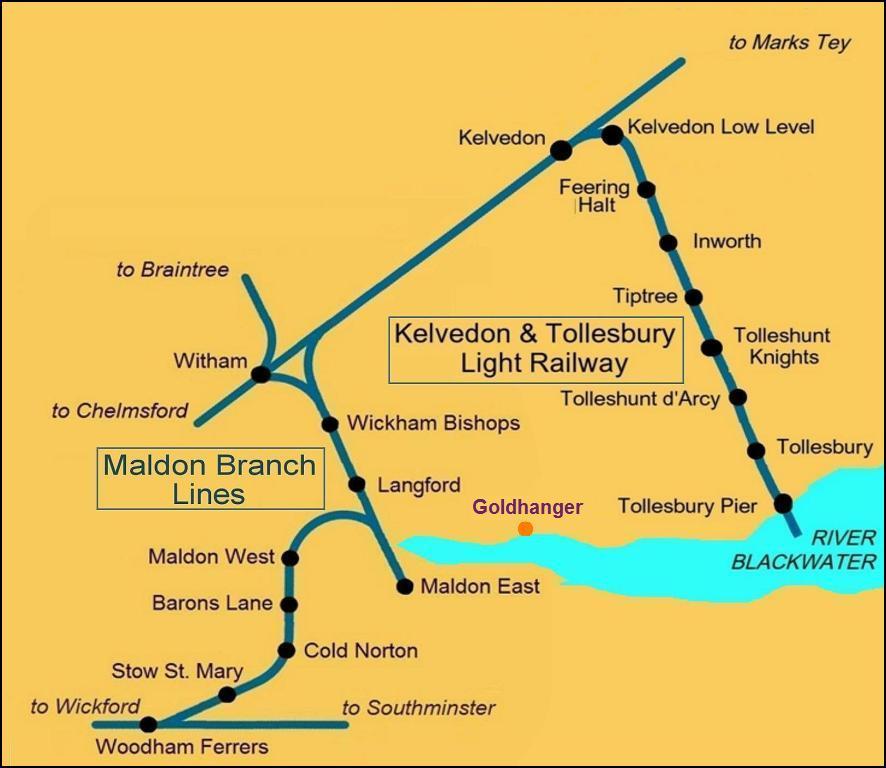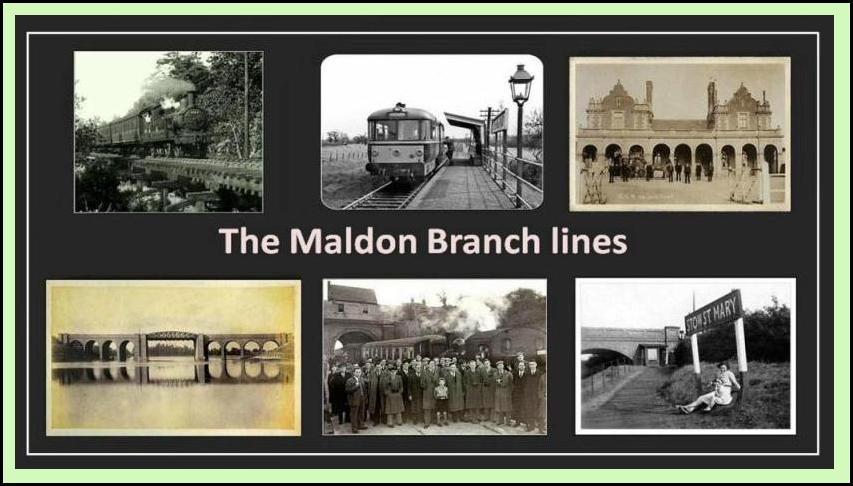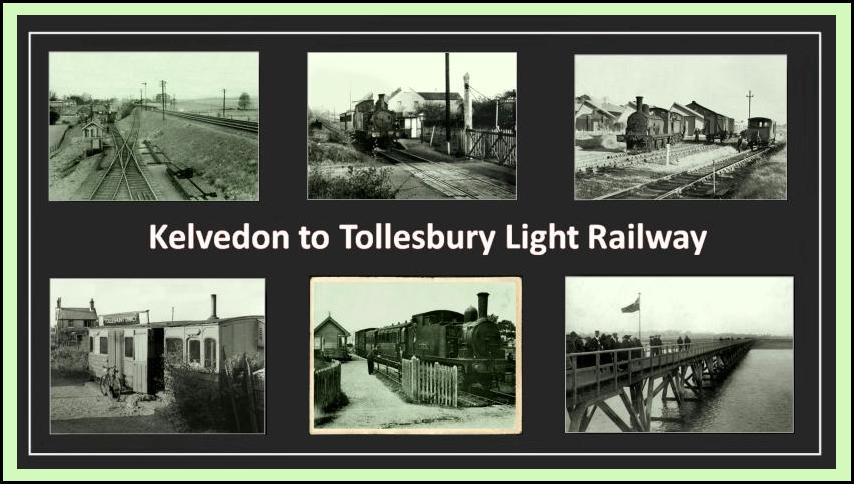|
Local railways in the
past |
|||
|
There
has never been a railway passing through Goldhanger, although it came very
close to happening in the late 1800s. There were two
separate proposals for a railway from Langford to Tollesbury, the first
in the 1882 that would have passed through Millbeach and Goldhanger, and
second in the 1890 that would have passed through Tolleshunt
Major/Beckingham. Langford was on the Maldon to Witham line, which was opened
in 1848. This is what the routes would have looked like... |
|||
|
The
Kelvedon to Tollesbury Light Railway, which became known locally as the “Crab
& Winkle line”, was finally opened in October 1904, going through Tiptree
to join the main line at Kelvedon. For over fifty years Goldhanger was
situated between these two lines - 4 miles to Maldon and Langford, and 3
miles to Tolleshunt D’arcy. The local archives contain an original 1919 Great
Eastern Railway “diagrammatic map” of all of East Anglia that measures 5 x
3ft. The container indicates it was posted to Maura
Benham in the early 1970s. Here are small sections that show the title
block and the local lines. Select one of the maps to zoom in on a high
definition version of the local lines... |
|||
|
Both
lines were single tracked, with the stations having two tracks and sidings
for goods wagons. The Kelvedon Tollesbury Light Railway was of a standard
gauge but was called “light” as it was built for light-weight engines and
carriages only and had low platforms. It had no signalling system as it only
ever had single engine and driver on it at any one time. It is easier to follow the routes on
a modern schematic diagram... |
|||
|
The
Crab & Winkle line was closed to passengers by British Railways in 1951
and the Maldon branch lines were closed as part of the “Beeching Axe” in
1964. Many Goldhanger residents used these lines in the years they were in
operation. Our records show these Goldhanger connections with the railways: -
Author Henry Coe Coape, who lived at Vaulty Manor in the mid 1800s, was a director of
many railway companies. -
The bellringers and choir made day trips to
other churches in the region, starting with a wagon ride to D’arcy. -
Ernest Mansfield and his
associates started their trips to Spitsbergen
by train in the early 1900s. -
Goldhanger GP Dr Henry Salter, who lived in
D’arcy was frequently travelled to London by train. -
Old Rectory fruit grower Charles Page
transported his apples to the Maldon stations in Model-T Ford trucks. -
Cyril Sothgate recalled moving to
Goldhanger from Suffolk via the Crab & Winkle line in the early 1930s. - The arrival of the rail line to
Maldon also had an indirect but significant effect on Goldhanger village
life. Cyril Sothgate also recalled that in his
youth the prosperity and expansion of several manufacturing companies in
Heybridge and Maldon, such as Bentalls, Sadds and
Maldon Iron Works, created many new job opportunities for Goldhanger
residents, offering higher wages and better working conditions for farm workers and fishermen, so
there was a daily mass exodus from the village on bicycles heading to Maldon. -
Jack Cohen’s Goldhanger Fruit Farms transported their canned products to
Maldon East goods yard in the 1950s. -
Crawshay Frost made many trips to London by
train between the 1920s and 1960s. - There have been several disused railway carriages in and around the
village used as accommodation. Here are two pictorial journeys
along the lines - based mainly on postcards from the period... |
|||
|
Includes thirty historic photos |
Kelvedon to Tollesbury Light
Railway includes thirty two historic photos |
||
|
Early timetables are available for both lines that give information
about the frequency of services and other information... |
|||
|
timetable
for 1869 |
timetable
for 1905 |
||
|
In 1869 the Maldon to Witham line had 5 trains a day
in each direction and 2 on Sundays. Landford was a "request stop".
By 1902 there were 10 trains, with about one per hour. On Sundays there were just four trains in each
direction. Between the 1930s and 1950s in the summers months
there were occasional through-trains to and from London. German built "rail buses" were introduced
in 1958. |
When the Tollesbury line first opened in 1904 there
were 4 trains a day in each direction on week days, with no trains on
Sundays. The fare from Tollesbury to Kelvedon was 9d on way (£4.50 in todays
money). In 1917 there were 5 trains a day, one every two
hours. the first train of the day was for goods only, calling at all the
goods sidings on the line. Horses and carriages could only be conveyed from
Tollesbury to Kelvedon. By 1950 just before the line closed they were down to
3 trains in each direction a day. |
||
|
|
|||
|
Since this webpage was originally
developed various videos and websites have appeared relating to these two lines, however
they mainly contain similar still images... Kelvedon and Tollesbury Crab &
Winkle Branch Line https://m.youtube.com/watch?v=a0IzumB7tUw
Lost Railways of East Anglia: Witham to Maldon in 1957 and 1963: https://www.youtube.com/watch?v=joeFuUvfiOo these videos also relate the to the
Witham to Maldon line produced by the Langford Power Museum: https://m.youtube.com/watch?v=L5En1xGKcnQ https://m.youtube.com/watch?v=g9tk-7gRs24 https://m.youtube.com/watch?v=jjHh0G4544U these websites were found in 2025: http://disused-stations.org.uk/features/kelvedon_and_tollesbury_light_railway/index.shtml
http://disused-stations.org.uk/t/tollesbury/index.shtml
http://disused-stations.org.uk/t/tollesbury/index1.shtml ttp://disused-stations.org.uk/m/maldon/index.shtml Witham to Maldon East in 1958, an
amatuer cine film in colour: https://player.bfi.org.uk/free/film/watch-witham-to-maldon-east-1957-online or https://www.facebook.com/100080174860060/videos/928218125260412 |
|||
|
return to... home Plans from the past that never happened - the railways Transport in the past |
|||



